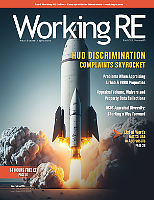 |
> The Appraiser Coach
> OREP E&O |
Five USPAP Myths Dispelled in 2024 USPAP
By Daniel A. Bradley, SRA, CDEI, McKissock Learning
On May 5, 2023, the Appraisal Standards Board (ASB) voted to adopt changes to the Uniform Standards of Professional Appraisal Practice (USPAP), which will become effective January 1, 2024. These represent the first changes to USPAP in four years. Many of the changes will not have a significant impact on the way appraisers practice but are nevertheless important for public trust.
Appraisers and the public have traditionally held several misconceptions about USPAP, and these changes should help to dispel some of those myths. There are five myths and misconceptions that are addressed in the changes to the 2024 USPAP.
Myth 1: USPAP Allows Discrimination as Long as the Appraiser’s Conclusions are Supported
Appraisers know this is not true, but there are some regulators, fair housing advocates, and members of the public who have perpetuated and even amplified this myth. For this reason, the ASB rewrote the ETHICS RULE and added a new “Nondiscrimination” section to clarify to users of appraisal services and the public that illegal discrimination is prohibited by USPAP.
There have been well-publicized accusations of bias and discrimination made against appraisers during the last several years. Regardless of whether these accusations have merit individually, collectively these accusations have damaged public trust in the appraisal profession. The previous language in the ETHICS RULE that prohibited an appraiser from using or relying on “unsupported conclusions” about protected characteristics had created the misconception that appraisers were permitted to engage in discrimination if their conclusions were supported. This was never the case; hence, the ASB removed this language.
The new Nondiscrimination section states that appraisers must not act “in a manner that violates or contributes to a violation of federal, state, or local antidiscrimination laws or regulations.” It also references three key federal antidiscrimination laws that are relevant to appraisal practice—the Fair Housing Act (FHAct), the Equal Credit Opportunity Act (ECOA) and the Civil Rights Act of 1866. The Nondiscrimination section also introduces the concepts of disparate treatment and disparate impact—concepts that are fundamental to understanding fair housing and fair lending laws and regulations.
The good news is that there are no new obligations for appraisers as a result of this new section of the ETHICS RULE. Appraisers have always been required by USPAP to be aware of, and comply with, laws and regulations that apply to the appraiser or to the assignment. Appraisers will need to comply with these laws in 2024, just as they were required to comply with them under previous editions of USPAP.
Referencing specific laws in the ETHICS RULE provides a reminder to appraisers of the importance of these laws, and it also clarifies an appraiser’s ethical obligations to comply with these laws for the benefit of users of appraisal services and the public. The Conduct section of the ETHICS RULE has retained its prohibition on performing an assignment with bias.
Two new Advisory Opinions that relate to the issue of fair housing and discrimination (AO-39 and AO-40) were also adopted by the ASB, and AO-16 has been retired. While Advisory Opinions do not establish any new standards and are not intended to be enforceable, they provide advice and illustrate applicability. AO-39 contains three illustrations of the applicability of anti-discrimination laws to appraisal assignments. AO-40 includes four illustrations of language in appraisal reports that could be considered discriminatory, and it also addresses the concepts of pretext and code words. These Advisory Opinions are valuable guidance that appraisers need to read and understand.
Myth 2: The Removal of the Definition of Misleading from USPAP Reduces Liability for Appraisers
Many appraisers believed the inclusion of the definition of “misleading” in USPAP created liability problems for appraisers, because an appraiser could potentially be disciplined under USPAP for minor inadvertent reporting errors. The ASB heeded the feedback from the appraisal community and retired this definition from USPAP for 2024. However, appraisers need to be aware that the retirement of a definition from USPAP does not remove the term from USPAP; it merely reverts the meaning of the term to its common English dictionary definition. Misleading is defined in the Cambridge Dictionary as “Causing someone to believe something that is not true.”
Even though the definition of misleading has been removed from USPAP, Standards Rule 2-2(a) requires an appraiser to “clearly and accurately set forth the appraisal in a manner that will not be misleading.” The communication of a misleading appraisal report is a violation of 2024 USPAP, just as it would have been under previous versions of USPAP. The difference is now, instead of turning to USPAP for a definition of misleading, courts, state regulatory agencies, and other entities will apply their own individual definitions of this term.
(story continues below)
(story continues)
Myth 3: An Inspection of the Subject Property by a Third Party is the Equivalent of a Personal Inspection by an Appraiser
The ASB revised the definition of “personal inspection” to clarify that it is “the appraiser’s in-person observation of the subject property performed as part of the scope of work.” There are three important elements in this revised definition.
First, a personal inspection is an inspection by an appraiser. An inspection of the property by another individual (e.g., a home inspector, or third-party data collector) does not qualify as a personal inspection under this definition.
Second, a personal inspection is an “in-person observation.” Viewing photos, videos, or drone footage does not quality as a personal inspection.
Finally, the inspection must be performed as part of the scope of work for the assignment. For example, if an appraiser had made a personal inspection of a property six months ago and is subsequently engaged to perform a new appraisal on the property, the appraiser cannot certify that they made a personal inspection of the property unless they inspected it again as part of the scope of work for the new assignment.
Edits were also made to Advisory Opinion 2, Inspection of Subject Property, to reflect the revised definition. AO-2 also clarifies that not all appraisal assignments require a personal inspection of the subject property as part of the scope of work.
Myth 4: Appraisers are not Required to Analyze Prior Non-Sale Transfers of the Subject Property
Under previous editions of USPAP, an appraiser had been required by Standards Rule 1-5(b) to “analyze all sales of the subject property that occurred within the three years prior to the effective date of the appraisal.” All sales are transfers, but not all transfers are sales. Some appraisers believed that because the word “sales” was used in SR 1-5(b), they were not required to analyze other transfers of property that did not qualify as sales. For example, a deed in lieu of foreclosure is not a sale, but it is a transfer of property ownership.
For 2024, the ASB revised the language in SR 1-5(b) to include the phrase “other transfers.” It now reads, “Analyze all sales and other transfers of the subject property that occurred within the three years prior.” Appraisers who were interpreting the previous language of this requirement literally and were therefore not analyzing non-sale transfers of the subject property (e.g., deed in lieu of foreclosure, gift transfers within families, etc.) will need to ensure that they analyze such transfers in future assignments.
The ASB also revised Advisory Opinion 1, Sale and Transfer History, to maintain consistency with the language in Standards Rule 1-5(b). As a reminder, in an Appraisal Report or a Restricted Appraisal Report, an appraiser is required to summarize the results of analyzing the sales and other transfers of the subject property.
Myth 5: The USPAP Update Course Cycle is the Same as the USPAP Publication Cycle
Throughout most of the 1990s, the USPAP publication was revised annually. The length of this update cycle was lengthened to 18 months in the early 2000s, and eventually became two years beginning with the 2008 USPAP. When it was initially published, the 2020 USPAP was intended to be effective for two years, but it was extended until December 31, 2023. The 2024 USPAP will become effective on January 1, 2024, but has no ending effective date. It will remain in effect until the ASB replaces it with an updated version.
This change to the USPAP publication cycle has no effect on the state-mandated requirement that an appraiser must complete the 7-hour USPAP Update Course every two years. The 2024 version of the 7-hour Update Course will be launched in late 2023, and another version of the course will be produced in two years hence, regardless of whether a new edition of USPAP has been released by the ASB.
Many state appraisal regulatory agencies have established requirements that specify when the 7-hour USPAP Update Course must be taken within an appraiser’s renewal cycle. Appraisers are advised to understand and comply with those requirements.
The ASB has produced two “Summary of Actions” documents outlining the changes to USPAP for 2024. The “short” version (three pages) and the “detailed” version (58 pages) can be accessed at appraisalfoundation.org.
The new 2024-2025 7-hour USPAP Update Course will be available in the fall of 2023. McKissock Learning is proud to be the only provider to offer The Appraisal Foundation’s official 7-hour National USPAP Update Course in three different formats—asynchronous (online), livestream (webinar), and live classroom delivery.
About the Author
Daniel Bradley is the Appraisal Curriculum and Content Director for McKissock Learning. Dan has been a real estate appraiser since 1987, and currently holds a certified general appraiser credential in Pennsylvania. His teaching style is relaxed with clear explanations of the material complemented by broad experience. Dan specializes in USPAP, expert witness appraisal, appraisal review, and FHA appraisals. He holds an SRA designation from the Appraisal Institute and served two terms on Pennsylvania’s appraiser licensing board.
OREP Insurance Services, LLC. Calif. License #0K99465




by Brent
“Analize” the contract and “Analize” prior sales and transfers. Sooooo here is the definition of Analize: verb (used with object),an·a·lyzed, an·a·lyz·ing.
to separate (a material or abstract entity) into constituent parts or elements; determine the elements or essential features of (opposed to synthesize):
to analyze an argument.
to examine critically, so as to bring out the essential elements or give the essence of:
A buyer has a contract to purchase a home for $300,000, no seller concessions, no contingencies. I’d love to hear an appraiser questioned in court what they did to separate into constituent parts or elements; determine the elements or essential features of or examine critically, so as to bring out the essential elements or give the essence of. A deed transfer putting into a trust would be another interesting one to hear.
I brought this up at a USPAP class and the instructor said it was insufficient to state the facts of the contract or transfer as its required to be analyzed. When I pressed for a more details on how exactly to do that they moved on to another topic.
-by Heather Brown
I agree, Brent! I can never seem to get answers to questions like this even in classes, either. Good job on analyzing the issue, even if no one wants to acknowledge you’re right!
-by Alain Orozco
If I were him I’d probably done the same thing…LOL. He does know either.
-Alain Orozco